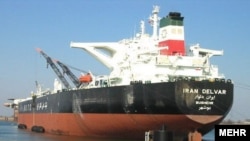The former chairman of Iranian parliament’s influential National Security and Foreign Policy Commission says that Iranian crude oil exports are currently twenty times less than what it was before sanction were imposed by Washington.
Speaking to the parliament's website, Khane-ye Mellat (the House of Nation), Heshmatollah Falahatpisheh called upon Iran's Foreign Ministry to devise a strategy to find a way out of the deadlock.
Before the new U.S. sanctions, Iran used to export nearly 2.5 million barrels of crude oil per day. The current Iranian budget is based on selling 1.5 million barrels per day.
Nonetheless, according to the International Monetary Fund (IMF), Iran's oil export (besides natural gas condensates) will be limited to 600,000 barrels per day (bpd). If this includes oil shipped overland to black markets in neighboring countries, it can be a realistic amount.
Although Falahatpisheh has not pinpointed the volume of crude oil currently exported by Iran, his reference to the term "twenty times less" shows that it has dropped to 125,000 bpd.
Meanwhile, data provided to Radio Farda by the Energy information and tankers tracker company, Kpler, indicate that Iran's oil export last September amounted to 131,000 bpd. The figure, with a slight difference, is the same as it has been published by the official website of China's customs department.
Last August, Iran's total oil exports was 160,000 barrels, 503,000 barrels less than the previous month.
Washington stopped renewing its waivers for Iranian oil buyers on May 2, but reportedly, China still buys Iranian crude in very limited amounts.
Iranian oil exports to the "known destinations" during the past nine months, Kpler says, was nearly 663,000 bpd, and to the "unknown destinations" nearly 265,000 bpd, on average; i.e., amounting to nearly 926,000 bpd on the average. But the January-April period was when Iran enjoyed some U.S. exemptions, selling around one million bpd.
In the meantime, Kpler data show, Iran's stockpile of unsold crude was more than 103 million barrels at the end of September, out of which nearly 50.5 million was stored on oil tankers, and the rest in ground storage facilities in Iran and China.
It is not yet clear what is the Islamic Republic's plan for its next year's budget, but there have been contradictory comments about the future of Iranian oil income and its impact on the country's next fiscal budget.
President Hassan Rouhani's adviser for Supervision and Strategic Affairs and the head of Plan and Budget Organization, Mohammad Baqer Nobakht, declared on October 29 that the government, for the first time, would present a biannual budget to Majles (parliament.)
Earlier on October 9, Nobakht had asserted, "We can say next year's budget does not rely on oil revenues and we will not spend even one rial of oil income on the current operating budget or on expenditures."
Furthermore, he said, since Tehran was under U.S. sanctions, Iran's oil revenues would only be consumed on purchasing capital assets and funding development projects.
Therefore, Nobakht argued, new sources of income should replace the income gained by exporting crude oil.
Nonetheless, he stopped short of elaborating on the "new sources" that were expected to compensate for the budget deficit.
Currently, the share of crude oil exports in the government's budget amounts to 34%. Still, the Minister of Finance and Economy Affairs, Farhad Dezhpasand, said on November 5 that the share has dropped to 24%.
The IMF forecasts Iran's exports of goods and services to drop to $60.3 billion this year from $103.2 billion last year and to fall further to $55.5 billion in 2020.
Global benchmark crude is trading around $62 a barrel. Iran needs it to rise to $196 to balance its budget next year, says the International Monetary Fund (IMF).
Iran's economy, IMF says, "has entered a steep recession," with GDP expected to drop by 9.5 percent this year.







